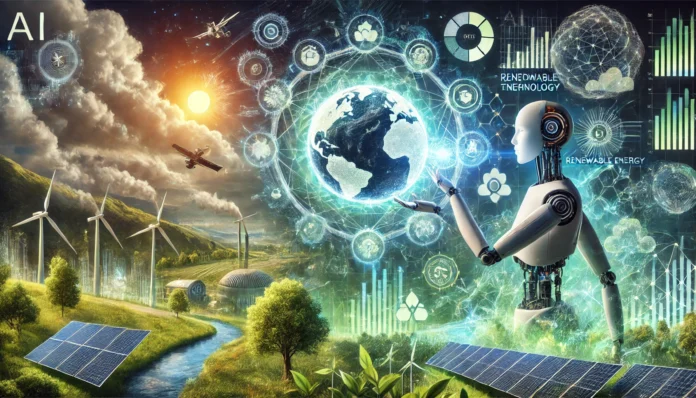Climate change is one of the most pressing challenges of our time, threatening ecosystems, economies, and communities worldwide. In the fight against this global crisis, artificial intelligence (AI) is emerging as a powerful tool to predict, mitigate, and adapt to the impacts of climate change. By analyzing vast amounts of data, optimizing resource use, and fostering innovative solutions, AI offers new ways to combat environmental degradation and drive sustainable practices.
AI’s Role in Predicting Climate Change
Accurate predictions are crucial for understanding the scale and impact of climate change. AI excels in processing massive datasets and identifying patterns, enabling more precise climate modeling and forecasting.
1. Climate Modeling and Weather Forecasting
AI-driven models simulate complex climate systems, offering insights into temperature changes, sea level rise, and extreme weather events. Machine learning algorithms refine these models by continuously integrating new data, improving their accuracy over time.
- Example: IBM’s Green Horizon Project uses AI to predict air pollution levels and analyze how weather patterns contribute to environmental changes.
2. Monitoring Deforestation and Biodiversity
AI-powered satellite imagery analysis detects changes in land use and deforestation, enabling real-time monitoring of critical ecosystems. These insights help policymakers take swift action to protect biodiversity and mitigate habitat loss.
- Example: Tools like Global Forest Watch use AI to monitor deforestation and provide actionable data to conservationists.
3. Identifying Emission Hotspots
AI systems analyze industrial and urban emissions data to pinpoint areas with high greenhouse gas output. This information supports targeted interventions to reduce emissions in the most impactful regions.
AI-Driven Actions for Mitigation
While prediction is essential, actionable solutions are the cornerstone of combating climate change. AI is driving transformative changes in how industries and communities reduce their carbon footprints.
1. Optimizing Energy Systems
AI helps optimize energy production and consumption by integrating renewable sources, predicting demand, and improving grid efficiency. Smart grids powered by AI enable better energy distribution, reducing waste and lowering emissions.
- Example: Google DeepMind reduced energy usage at its data centers by 40% using AI to optimize cooling systems, showcasing the potential for AI to improve energy efficiency.
2. Enhancing Renewable Energy Adoption
AI supports the transition to renewable energy by predicting wind and solar patterns, enabling better planning and integration into the power grid. These technologies make renewable energy sources more reliable and cost-effective.
- Example: Companies like Xcel Energy use AI to predict solar energy generation, ensuring stable energy supply even during fluctuating weather conditions.
3. Sustainable Agriculture
Agriculture is both a contributor to and a victim of climate change. AI helps farmers adopt sustainable practices by monitoring soil health, predicting crop yields, and optimizing resource use, such as water and fertilizers.
- Example: Platforms like Climate FieldView use AI to provide farmers with data-driven insights, promoting precision agriculture and reducing environmental impact.
AI for Climate Adaptation
Adapting to the inevitable impacts of climate change is just as important as mitigation. AI aids communities in building resilience against rising temperatures, extreme weather, and other challenges.
1. Disaster Prediction and Management
AI enhances disaster preparedness by predicting events such as floods, hurricanes, and wildfires. Early warnings allow authorities to take preventive measures, minimizing damage and saving lives.
- Example: One Concern, an AI platform, predicts the impact of natural disasters, helping cities plan their responses more effectively.
2. Urban Planning for Resilience
AI tools analyze urban vulnerabilities and recommend adaptive strategies, such as green infrastructure, improved drainage systems, and energy-efficient building designs.
- Example: AI-driven platforms like Spacemaker help architects design sustainable and resilient urban environments.
Challenges and Ethical Considerations
While AI holds immense potential, its integration into climate action is not without challenges:
- Data Accessibility and Bias: Reliable climate data is essential for AI to function effectively. However, data gaps and biases can limit the accuracy of AI models, particularly in underrepresented regions.
- High Energy Consumption: AI technologies themselves consume significant energy, particularly in training large models. Efforts are needed to make AI development more energy-efficient.
- Ethical Concerns: AI systems must prioritize transparency and inclusivity, ensuring that climate solutions benefit all communities, especially those most vulnerable to climate change.
The Future of AI in Climate Action
The role of AI in combating climate change will only grow as technology advances. Emerging trends include:
- AI-Driven Carbon Capture: Machine learning algorithms are being used to optimize carbon capture and storage technologies, making them more effective and scalable.
- Decentralized Climate Monitoring: AI-powered Internet of Things (IoT) devices will enable real-time environmental monitoring on a global scale.
- Global Collaboration Platforms: AI will facilitate international cooperation by providing shared platforms for climate data analysis and resource optimization.
Conclusion
AI is a transformative force in the fight against climate change, offering innovative solutions for prediction, mitigation, and adaptation. By harnessing the power of AI, we can make data-driven decisions, optimize resources, and implement effective strategies to address the environmental challenges of our time.
However, to fully realize AI’s potential, we must address its limitations and ensure that its deployment is ethical, inclusive, and sustainable. Collaboration between governments, businesses, and technology developers will be key to leveraging AI as a tool for creating a greener and more resilient future.





